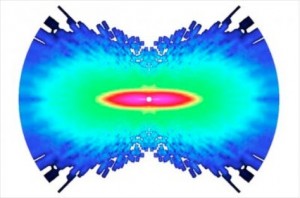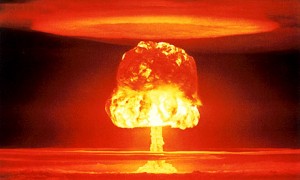Facts About Atoms
At the centre of every atom is a nucleus containing protons and neutrons. Together, protons and neutrons are known as nucleons. Around this core of the atom, a certain number of electrons orbit in shells.
The nucleus and electrons are referred to as subatomic particles. The electrons orbit around the centre of the atom, which is due to the charges present; protons have a positive charge, neutrons are neutral and electrons have a negative charge. It is the electromagnetic force that keeps the electrons in orbit due to these charges, one of the four fundamental forces of nature. It acts between charged objects – such as inside a battery – by the interaction of photons, which are the basic units of light.
An atom is about one tenth of a nanometre in diameter. 43 million iron atoms lined up side by side would produce a line only one millimetre in length. However, most of an atom is empty space. The nucleus of the atom accounts for only a 10,000th of the overall size of the atom, despite containing almost all of the atom’s mass. Protons and neutrons have about 2,000 times more mass than an electron, making the electrons orbit the nucleus at a large distance.
 An atom represents the smallest part of an element that can exist by itself. Each element’s atoms have a different structure. The number of protons inside a specific element is unique. For example, carbon has six protons whereas gold has 79. However, some elements have more than one form. The other forms – known as isotopes – of an atom will have the same number of protons but a totally different number of neutrons. For example, hydrogen has three forms which all have one proton; tritium has two neutrons, deuterium has one neutron and hydrogen itself has none.
An atom represents the smallest part of an element that can exist by itself. Each element’s atoms have a different structure. The number of protons inside a specific element is unique. For example, carbon has six protons whereas gold has 79. However, some elements have more than one form. The other forms – known as isotopes – of an atom will have the same number of protons but a totally different number of neutrons. For example, hydrogen has three forms which all have one proton; tritium has two neutrons, deuterium has one neutron and hydrogen itself has none.
As different atoms have different numbers of protons and neutrons, they also have different masses, which determine the properties of an element. The larger the mass of an atom the smaller its size, as the electrons orbit more closely to the nucleus due to a stronger electromagnetic force. For example an atom of sulphur, which has 16 protons and 16 neutrons, has the same mass as 32 hydrogen atoms, which each have one proton and no neutrons.
What makes up an atom?
Shell – Each shell can hold a different number of electrons. The first can hold 2, then 8,18,32 a nd so on.
Protons – A stable elementary particle with a positive charge equal to the negative charge of an electron. A proton can exist without a neutron, but not vice versa.
Electron – An elementary particle (one of the basic particles of matter), an electron has almost no mass and a negative charge.
Neutrons – An elementary particle with a neutral charge and the same mass as a proton. The number of neutrons defines the other forms of an element.
Nucleus – Held together by the strong nuclear force, the strongest force in nature, the nucleus is tightly bound and holds the protons and neutrons.
Quantum jump – An electron releases or absorbs a certain amount of energy when it jumps from one shell to another, known as a quantum leap.
Fact about the atomic bomb
 Atomic bombs are notorious for their devastating power. By harnessing the energy in the nucleus of an atom, atomic bombs are one of the most powerful man-made weapons. In 1939, Albert Einstein and several other scientists told the USA of a process of purifying uranium, which could create a giant explosion known as an atomic bomb. This used a method known as atomic fission to ‘split’ atoms and release a huge amount of energy.
Atomic bombs are notorious for their devastating power. By harnessing the energy in the nucleus of an atom, atomic bombs are one of the most powerful man-made weapons. In 1939, Albert Einstein and several other scientists told the USA of a process of purifying uranium, which could create a giant explosion known as an atomic bomb. This used a method known as atomic fission to ‘split’ atoms and release a huge amount of energy.
The only two bombs to ever be used in warfare were a uranium bomb on Hiroshima and a Plutonium bomb on Nagasaki in 1945 at the end of World War II. The effects were frighteningly powerful, and since then no atomic bomb has ever been used as a weapon.

